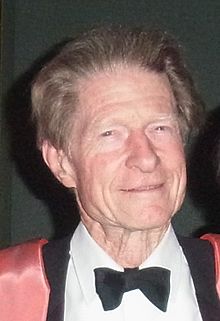John Gurdon
Appearance

Sir John Bertrand Gurdon (born 2 October 1933) is an English zoologist, who shared the 2009 Lasker Award and shared the 2012 Nobel Prize for Physiology or Medicine with Shinya Yamanaka for stem cell research.
| This scientist article is a stub. You can help out with Wikiquote by expanding it! |
Quotes
[edit]- Michail Fischberg was well aware of the value of genetics in developmental biology, and when I joined him, he had just started using Xenopus as a laboratory animal, on the grounds that it could be grown to sexual maturity within a year and that, as it is wholly aquatic, it is easy to keep in the laboratory. Xenopus can deliver eggs throughout the year, in contrast to the limited-season availability of eggs from Rana and European newts, the organisms of choice for European embryologists. The history of how a frog that naturally occurs only in Africa has come to be one of the half-dozen most used animals for research is bizarre (Gurdon & Hopwood 2000).
- (2006). "From Nuclear Transfer to Nuclear Reprogramming: The Reversal of Cell Differentiation". Annual Review of Cell and Developmental Biology 22 (1): 1–22. ISSN 1081-0706. DOI:10.1146/annurev.cellbio.22.090805.140144. (quote from p. 3)
- For these early results in Xenopus to be reproduced in mammals took nearly 40 years (Campbell et al. 1996; Wilmut et al. 1997) in sheep. A very important feature of these first successful mammalian nuclear transfer in sheep was the use of unfertilised eggs, as was actually used in amphibia. Earlier work with mice (McGrath and Solter 1984) used fertilised eggs. Although fertilised eggs can be used (Egli et al. 2007), synchronisation between nucleus and egg is harder to achieve than with the use of unfertilised eggs. A very elegant and important experiment that confirmed the general principle that cell differentiation proceeds with the retention of a complete set of genes was carried out using nuclei with a rearranged genome from mature mouse B or T donor cells (Hochedlinger and Jaenisch 2002). In the course of time, somatic cell nuclear transfer to eggs has been successful in the eggs of mice and other mammals (Wakayama et al. 1998). In each species there seem to be some technical requirements which have to be identified and overcome.
- Sir John B. Gurdon — Nobel Lecture. nobelprize.org (7 December 2012). (quote from pp. 238–239 of The Egg and the Nucleus)
- Cells specialise in ways determined by the concentration of signal that they receive ... The best example of signaling between cells is by the signal molecule activin, discovered in embryos by Makoto Asashima and J. C. Smith.
- Lecture by Nobel Laureate, Sir John B. Gurdon. HiroshimaUniv, YouTube (April 7, 2016). (quote from 4:59 of 1:02:10 in video)
- My own view of development is that one has to try to narrow things down to single entities, whether it's a cell or a nucleus or a molecule, and I'm often ridiculed because I always ask people what concentration their molecule is at, and they'll say that it doesn't matter.
I'd say that concentration and time are the two critical things in development. You need to know the concentration, and you need to know how long it has to be there to make a difference – because for cells, a particular concentration of a molecule for a few seconds may not be the same as that concentration for 10 minutes. So I would take the view that what we really lack in developmental biology at the moment is any ability to determine the concentration of proteins, analogous to the measurement of nucleic acids using PCR.- as quoted by Aidan Maartens: (2017). "An interview with John Gurdon". Development 144 (9): 1581–1583. ISSN 0950-1991. DOI:10.1242/dev.152058.
Quotes about Gurdon
[edit]- Gurdon's (1962) nuclear transplantation experiments showed that genes were neither lost nor permanently inactivated during development. Upon transfer of an intestinal cell nucleus into an enucleated egg, entire swimming tadpoles developed. However, the frequency of this event was low, unless nuclei were first injected into oocytes (DiBerardino et al., 1986), a step that might allow reprogramming by stripping the DNA of mitotically heritable regulatory influences. Thus, although these experiments provided strong evidence that differentiation was reversible, they did not determine whether genes were silenced by active or passive mechanisms in the course of development.
- Helen M. Blau and David Baltimore: (1991). "Differentiation requires continuous regulation.". Journal of Cell Biology 112 (5): 781–783. ISSN 0021-9525. DOI:10.1083/jcb.112.5.781.
External links
[edit]Categories:
- Scientist stubs
- 1933 births
- Living people
- University of Cambridge faculty
- Biologists from England
- Nobel laureates in Physiology or Medicine
- Nobel laureates from England
- Non-fiction authors from England
- Zoologists from England
- Wolf Prize in Medicine laureates
- University of Oxford alumni
- University of Oxford faculty
- Fellows of the Royal Society


